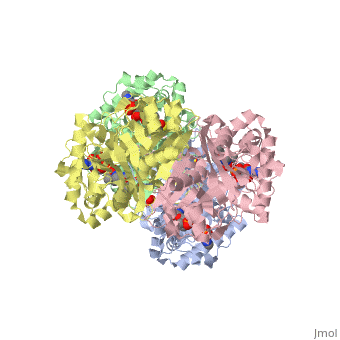User:Satyan Sharma/Sandbox 1
From Proteopedia
| Line 1: | Line 1: | ||
| - | Introduction | ||
| - | The reaction mechanism | ||
<applet load='1dm3' size='300' frame='true' align='right' caption='Insert caption here' /> | <applet load='1dm3' size='300' frame='true' align='right' caption='Insert caption here' /> | ||
| + | == Introduction == | ||
| + | |||
| + | Thiolase is best known as key enzyme in the β-oxidation of fatty acid degradation pathway. However, in the human metabolism at least six thiolases have been characterized. Each of them is important in different pathways, and in different organelles. Some of the thiolases are dimers, some thiolases are tetramers, being dimers of dimers. Thiolases are involved, either in degradative pathways (E.C.2.3.1.16), or in biosynthetic pathways (E.C.2.3.1.9). This division is somewhat arbitrary as all thiolases are aequence related to each other. | ||
| + | |||
| + | Figure 1 shows the thiolase reaction in the degradative direction. In the degradative reaction acetoacetyl-CoA is degraded with CoA as cosubstrate and by which two molecules of acetoacetyl-CoA are formed. Each thiolase catalyzes this reaction in both directions, but the equilibrium is far much favouring the degradative direction (K<sub>eq</sub> is 10<sup>5</sup>, favoring the degradation). The reaction is catalysed by the enzyme as a two step process. In the first step a fully conserved active site cystiene, Cys89 is acetylated liberating acetyl-CoA. In the second step the acetyl-moiety is transferred to CoA (Figure 1). | ||
| + | |||
| + | The best studied thiolase is the ''Zoogloea ramigera'' thiolase, which is a biosynthetic thiolase and catalyzes the formation of actoacetyl-CoA from two molecules of acetyl-CoA (Figure 2). The enzymological properties of ''Zoogloea ramigera'' thiolase have been extensively characterized by C.T. Wals and coworkers(REF-1) and more recently its structural enzymologiacl properties have also been characterized. (REF-2). | ||
| + | |||
| + | == The reaction mechanism == | ||
| + | |||
This thiolase is a tetramer, indeed a dimer of dimers. The <scene name='User:Satyan_Sharma/Sandbox_1/Acsite/1'>active site</scene> is deeply buried. It is constructed by four loops, which provide the catalytic nucleophile (Cys89), the base (Cys378), as well as Asn316 and His348. | This thiolase is a tetramer, indeed a dimer of dimers. The <scene name='User:Satyan_Sharma/Sandbox_1/Acsite/1'>active site</scene> is deeply buried. It is constructed by four loops, which provide the catalytic nucleophile (Cys89), the base (Cys378), as well as Asn316 and His348. | ||
Revision as of 06:43, 7 April 2010
|
Introduction
Thiolase is best known as key enzyme in the β-oxidation of fatty acid degradation pathway. However, in the human metabolism at least six thiolases have been characterized. Each of them is important in different pathways, and in different organelles. Some of the thiolases are dimers, some thiolases are tetramers, being dimers of dimers. Thiolases are involved, either in degradative pathways (E.C.2.3.1.16), or in biosynthetic pathways (E.C.2.3.1.9). This division is somewhat arbitrary as all thiolases are aequence related to each other.
Figure 1 shows the thiolase reaction in the degradative direction. In the degradative reaction acetoacetyl-CoA is degraded with CoA as cosubstrate and by which two molecules of acetoacetyl-CoA are formed. Each thiolase catalyzes this reaction in both directions, but the equilibrium is far much favouring the degradative direction (Keq is 105, favoring the degradation). The reaction is catalysed by the enzyme as a two step process. In the first step a fully conserved active site cystiene, Cys89 is acetylated liberating acetyl-CoA. In the second step the acetyl-moiety is transferred to CoA (Figure 1).
The best studied thiolase is the Zoogloea ramigera thiolase, which is a biosynthetic thiolase and catalyzes the formation of actoacetyl-CoA from two molecules of acetyl-CoA (Figure 2). The enzymological properties of Zoogloea ramigera thiolase have been extensively characterized by C.T. Wals and coworkers(REF-1) and more recently its structural enzymologiacl properties have also been characterized. (REF-2).
The reaction mechanism
This thiolase is a tetramer, indeed a dimer of dimers. The is deeply buried. It is constructed by four loops, which provide the catalytic nucleophile (Cys89), the base (Cys378), as well as Asn316 and His348.

